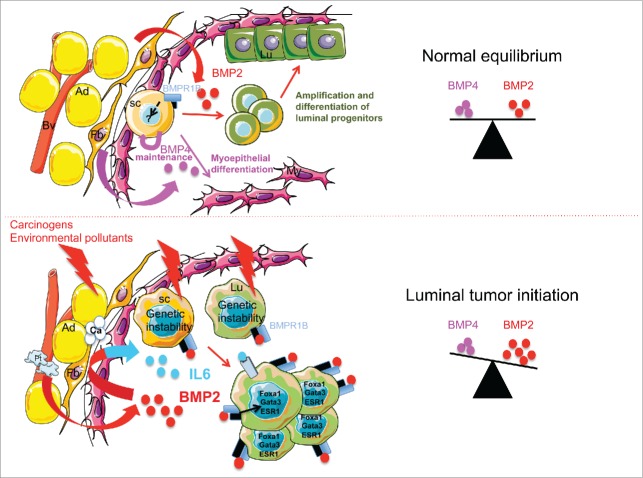Figure 1.
Proposed mechanism for bone morphogenetic protein (BMP) function to maintain normal equilibrium and how this this equilibrium is disrupted by environmental pollutants. In normal breast, stem cells (SC) reside in a niche composed of adipocytes (Ad), fibroblasts (Fb), and blood vessels (Bv), that provide cytokines such as BMP2 and BMP4 to maintain normal equilibrium and tissue homeostasis. By binding to bone morphogenetic protein receptor 1B (BMPR1B), BMP2 regulates the amplification and differentiation of luminal progenitors (Lu) whereas BMP4 seems to maintain stem cells and regulate the myoepithelial lineage (My). Downstream intracellular pathways involved in these mechanisms remain to be deciphered. Over the course of a lifetime, the tissue is exposed to a number of pollutants affecting the cellular components of the niche and the different mammary cell types. This can lead to an intrinsic genetic instability among stem cells and progenitors but also to altered extrinsic signals from the niche. BMP2 secretion is increased mainly around blood vessels (Bv) by endothelial and recruited platelets (Pt). A local high concentration of BMP2 leads to increased inflammation and IL6 production from the niche and affects differentiation of stem cells and progenitors via activation of intrinsic signaling pathways. This process contributes to the emergence of cells with luminal features such as high levels of forkhead box A1 (FOXA1), GATA binding protein (GATA3), and estrogen-related genes (estrogen receptor 1 ESR1), and high levels of BMPR1B. Disequilibrium of BMP2 levels might also lead to changes in the niche structure such as local microcalcification (Ca), another early step in the emergence of breast luminal tumors.

